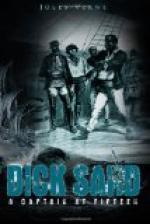From early morning all was intense animation on the vast “tchitoka” of Kazounde, and it is difficult to give a proper idea of the scene. It was a concourse of four or five thousand persons, including Alvez’s slaves, among whom were Tom and his companions. These four men, for the reason that they belonged to a different race, are all the more valuable to the brokers in human flesh. Alvez was there, the first among all. Attended by Coimbra, he offered the slaves in lots. These the traders from the interior would form into caravans. Among these traders were certain half-breeds from Oujiji, the principal market of Lake Tanganyika, and some Arabs, who are far superior to the half-breeds in this kind of trade.
The natives flocked there in great numbers. There were children, men, and women, the latter being animated traders, who, as regards a genius for bargaining, could only be compared to their white sisters.
In the markets of large cities, even on a great day of sale, there is never much noise or confusion. Among the civilized the need of selling exceeds the desire to buy. Among these African savages offers are made with as much eagerness as demands.
The “lakoni” is a festival day for the natives of both sexes, and if for good reasons they do not put on their best clothes, they at least wear their handsomest ornaments.
Some wear the hair divided in four parts, covered with cushions, and in plaits tied like a chignon or arranged in pan-handles on the front of the head with bunches of red feathers. Others have the hair in bent horns sticky with red earth and oil, like the red lead used to close the joints of machines. In these masses of real or false hair is worn a bristling assemblage of skewers, iron and ivory pins, often even, among elegant people, a tattooing-knife is stuck in the crisp mass, each hair of which is put through a “sofi” or glass bead, thus forming a tapestry of different-colored grains. Such are the edifices most generally seen on the heads of the men.
The women prefer to divide their hair in little tufts of the size of a cherry, in wreaths, in twists the ends of which form designs in relief, and in corkscrews, worn the length of the face. A few, more simple and perhaps prettier, let their long hair hang down the back, in the English style, and others wear it cut over the forehead in a fringe, like the French. Generally they wear on these wigs a greasy putty, made of red clay or of glossy “ukola,” a red substance extracted from sandal-wood, so that these elegant persons look as if their heads were dressed with tiles.
It must not be supposed that this luxury of ornamentation is confined to the hair of the natives. What are ears for if not to pass pins of precious wood through, also copper rings, charms of plaited maize, which draw them forward, or little gourds which do for snuff-boxes, and to such an extent that the distended lobes of these appendages fall sometimes to the shoulders of their owners?




